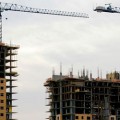The situation of companies in the construction sector closely reflects the world, regional and national economic trends. At a time when the world economy is characterized by divergences between countries, with a recession in the euro zone, there are significant disparities between countries and subsectors. The construction sector was badly hit by the 2009 crisis, and a large number of payment incidents were still occurring in 2011.
Sensitivity to economic conditions specific to each market and subsector
The intensity of activity in the construction sector vary according to the impact of the crisis on the economy of the concerned country and according to sensitivity to economic conditions that varies from one subsector to another. Activity is strong in emerging markets that are making up for lagging development, and this is particularly favourable to certain subsectors, such as public works and private and institutional non-residential construction. Conversely, activity in developed markets is either moderate or stagnant, with particularly large disparities in the residential construction sector linked to differences in demographics, economic environments, credit terms, fiscal legislation, stocks of vacant housing, and prices.
This fragile and variable economic climate, combined with changes in orders from the public sector and regulations as well as fluctuations in both costs of materials and demand, explain the increase in payment incidents during the early months of the crisis in 2008 and again from October 2011 onwards.
Construction in Europe will depend on the austerity plans in 2012
After a three-year decline and a 17% drop in activity over the period, the European construction sector at last almost stabilized in 2011, particularly in the residential subsector, despite disparities between European countries that can be divided into three groups:
• The first group is the one where construction has suffered the most, and where the cleaning up will take some time. Ireland, Iceland, Spain, Denmark, the Netherlands, Greece and Central Europe have been affected by significant excesses in pricing and supply, and keep seeing a large number of payment incidents.
• The second group, United Kingdom, France, Belgium and Italy, has suffered less from the crisis and business even bounced back in 2010. Despite this, a new decline has set in due to the persistence of excessively high prices. Payment incidents are still widespread, particularly in the UK where the number of corporate bankruptcies is the most significant.
In France, companies face tough competition and fight to win contracts even if this means sometimes tightening their margins while taking into account price increases for raw materials. There were fewer bankruptcies in the first quarter of 2011 than in the first quarter of 2010, although the number remains much higher than before the crisis.
• The third group is made up of European countries where the crisis has not affected the construction sector: Germany, Austria, Norway, Sweden, Finland and Poland. Bankruptcies are nevertheless higher than in other sectors, mainly affecting companies whose activity is regional and which work in a single sector.
For 2012, Coface forecasts a very modest advance in construction in Europe, if the upturn of the housing segment continues. The construction sector will, however, be affected by austerity plans. Public works and institutional building are expected to stagnate under the influence of budget restrictions. Construction of business and industrial premises is likely to be affected by economic uncertainties.
North America: large disparity between the US and Canada
In the United States, falling prices combined with rising costs have weakened the entire sector. Investment in construction fell by 2% in the first 11 months of 2011. Although the decline affects most subsectors, the new building segment has been especially weakened. Non-residential construction also continues to suffer due to budget difficulties of the States and Cities. In Canada, the recovery that began in early 2010 explains the low level of payment incidents recorded by Coface. A sharp slowdown is nevertheless expected in the housing segment in 2012 following the introduction of more stringent credit access conditions.
Asia-Pacific: upturn in activity
Construction in the Asia-Pacific zone is relatively buoyant. Activity is expected to recover fairly well in 2012 in Japan and New Zealand, both affected by environmental disasters, in response to the need for reconstruction. In Australia, in the short term, economic uncertainties are likely to hinder the dynamism of the sector, but activity is expected to pick up in the medium term thanks to favourable demographics.
• The case of China
Sales have fallen in China since 2010 following the steps taken by the authorities to cool down the property market, in particular by restricting bank loans to the sector. The drop in sales, price adjustments and increased stock levels are expected to slightly slow the activity in the private residential segment, but this will be partly offset by the launch of a new public social housing construction programme.
The building boom has seen world-class players emerge in China, not only in the construction companies but also as producers of raw materials and machinery manufacturers. These newcomers are more and more active in emerging zones, particularly in Africa and the Middle East.











